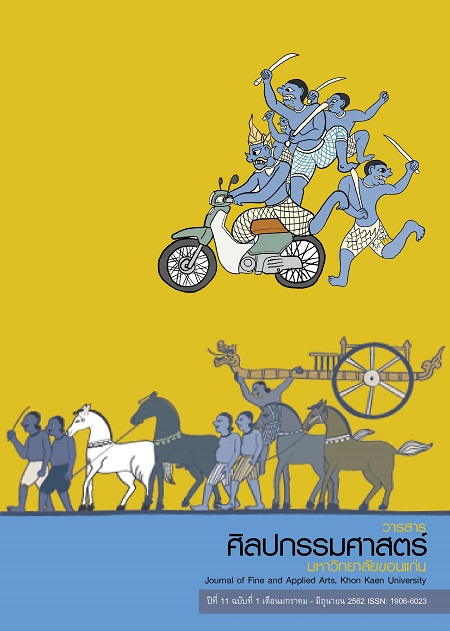Creative forms Laipin in E-san Country Songs for Rewat Sayankena (Noom Putai)
Main Article Content
Abstract
RewatSayankenaalso known as NoomPutai is one of composers who put Pin to create music. Especially, LukThungE-san. The Lai Pin melody is used to create a unique LukThungE-san melody. This research aims to : 1) To study the history and works of RewatSayankena 2) To analyze the pattern of LukThungE-san songs of RewatSayankena. This research is a qualitative research. The research tools were : Preliminary surveys,Interviews and Observations. Field information is obtained from interviews and observations from a 6 expertsand 1 technician.Describe the results of data analysis by descriptive analysis. The research results are as follows:
- The history and works of Rewat Sayankena. He started practicing the Pin at the age of 10 from his Grandfather, there are 3 songs including Lai Groen, Lai Putai and Lai Lam Ploen. Later in 1966, he practiced guitar. And played with the dance band, Dok FaPutai Band in Pin Position. Work in Bangkok in 1972. Playing music at a restaurant, a guitarist. Then began recording the first, from the persuasion of SorapetPinyo. He createdtheir 3rd album Noom Na Kao Sao Na Glao. It is popular with Noom Na Kao Sao Na Glao, vocal by SorapetPinyo and NoodDuangchiwan in 1981.The song was a popular and respected song of the fans until it was honored with a Medal Gold Record from Princess MahaChakriSirindhorn in 1982. Later it became known as NoomPutai the Composer. The award-winning works and the reputation, for example, in 1997 Medal Ganesh Goldwith Sang Nang from Princess MahaChakriSirindhorn. From the past, he has been behind the creation of LukThungsongs in Thailand for musician, singer such as YardNapalai, SiripornAmpaipong, JintaraPoonlarp, ChalermpolMalakham etc. Also, the music that originated to the popular is always popular with fans.Currently, RewatSayankena made the recording studio "NoomPutai Studio" and taught those who are interested in learning Pin in Bangkok.
- The analysis of the pattern of Lai Pin in LukThung E-san from RewatSayankena. The researcher analyzed 3 songs : 1) Sao Na Ha Rak 2) Lam Nam Pong 3) Sang Nang. It was found that the melody of Lai Pin was constructed from the structure of E-san Folk pattern, there are 2 types of patterns: Main Melody is Intro, Solo, Coda and Sub Melody is Lai Pin in each section. By 2 types of notes are used in the scale such as minor pentatonic and pentatonic scale.
Main Melody is Conjunct motion and Disjunct motion. Moves the note 1st to the 2nd , 3rd , 4th, 5th ,6th and 7th, by phrasingnote 1st to the 2nd , 3rd , 4th, 5th ,6th and 7th of intervals on up - down movement steadily. The main melody is grouped, each group of 6 notes. Creating a melody pattern from the first note to the last note of each melody, by switch back-and-forth on scale.
Sub Melody is as follows : 1) Improvised Melody 2) Rhythm Line and 3) Counterpoint. Every move is Conjunct motion and Disjunct motion, moves the note 1st to the 2nd , 3rd , 4th, 5th and 6th, by phrasingnote 1st to the 2nd , 3rd , 4th, 5thand ,6th of intervals on up - down movement steadily. Creating a melody pattern from the first note to the last note of each melody, by switch back-and-forth on scale.
The research found that RewatSayankena, he created Lai Pin in E-san LukThung from these of 4 melodies such as 1) E-san Folk Melody 2) Improvised Melody 3) RhythmLai 4) Counterpoint
Article Details
Content and information in articles published in the Journal of Fine and Applied Arts of Khon Kaen University is regarded as the opinion and sole responsibility of the author(s) directly; therefore, editors are not obliged to agree to or share any responsibility with regard to the content and information that appears within these articles.
All articles, information, content, image, etc. that have been published in the Journal of Fine and Applied Arts of Khon Kaen University is the copyright of the Journal of Fine and Appllied Arts of Khon Kaen University. Any person or organization who wishes to distribute all or parts of the articles for further dissemination or other usage must first receive permission from the Journal of Fine and Applied Arts of Khon Kaen University before proceeding to do so.
References
เฉลิมศักดิ์ พิกุลศรี. (2536). วัฒนธรรมอินเดียในดนตรีไทยและเอเชียตะวันออกเฉียงใต้ ดนตรีไทยอุดมศึกษาครั้งที่ 23. ขอนแก่น : มหาวิทยาลัยขอนแก่น.
สุกัญญา ภัทราชัย. (2532).วัฒนธรรมพื้นบ้าน. กรุงเทพฯ: กรมการศาสนา.
รุ่งสุริยา เมืองเหลา. (2537). ภาพสะท้อนสังคมอีสานซึ่งปรากฏในบทเพลงที่พรศักดิ์ ส่องแสงขับร้อง. ปริญญานิพนธ์ ศิลปศาสตรมหาบัณฑิต วิชาเอกภาษาไทย (เน้นมนุษยศาสตร์). มหาสารคาม :มหาวิทยาลัยศรีนครินทรวิโรฒ มหาสารคาม.


